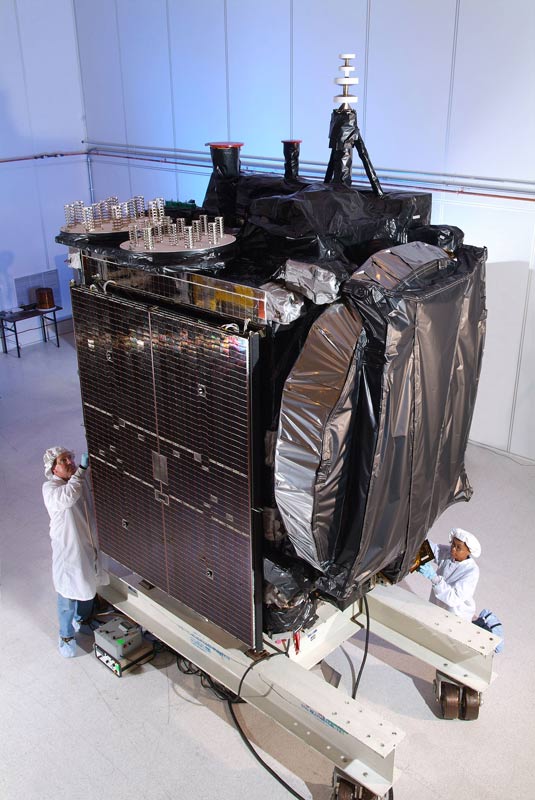Out-of-Control Satellite Threatens Other Nearby Spacecraft

PARIS - An adrift Intelsat satellite thatstopped communicating with its ground controllers last month remains out ofcontrol and has begun moving eastward along the geostationary arc, raising thethreat of interference with other satellites in its path, Intelsat and otherindustry officials said.
In what industry officials called anunprecedented event, Intelsat?s Galaxy 15 communications satellite has remainedfully ?on,? with its C-band telecommunications payload still functioning evenas it has left its assigned orbital slot of 133 degrees west longitude 36,000kilometers over the equator.
Galaxy 15 stopped responding to groundcontrollers on April 5. The satellite's manufacturer, Orbital Sciences Corp. ofVirginia, has said an intensesolar storm in early April may be to blame. It was launched into space in2005.
The first satellite likely to face signalinterference problems from the adrift Galaxy 15 is the AMC-11 C-band satelliteowned by SES of Luxembourg and stationed at 131 degrees west, just two degreesaway from Galaxy 15?s starting position.
Rob Bednarek, chief executive of the SESWorld Skies division, which operates AMC-11, said Intelsat and SES have beenmeeting since April 5 to coordinate how to minimize the Galaxy 15 impact on AMC-11?smedia customers. [Spotsatellites from Earth.]
Adrift in space
In an interview Friday, Bednarek said thatwhile it remains unclear whether SES World Skies will be able to avoid a signalinterference problem as Galaxy 15 enters the AMC-11 orbital territory, thecompany has benefited from full disclosure on the part of Intelsat, SES?sbiggest competitor.
Breaking space news, the latest updates on rocket launches, skywatching events and more!
?The cooperation with them really has beenvery good,? Bednarek said. ?We all realize that we could be in the sameposition tomorrow. We are neighbors in space.?
Alan Young, chief technology officer at SESWorld Skies, said the company?s best estimate is that Galaxy 15 will enterAMC-11?s neighborhood ? meaning one-half of one degree distant ? May 23. Itwill continue traveling at its own pace through the AMC-11 slot, exiting on theeast around June 7.
Young said the period of May 31 to June 1 isgoing to be the riskiest time for AMC-11 customers as SES World Skies seeks tomaneuver AMC-11 to the maximum extent possible out of the Galaxy 15 track whileat the same time maintaining links with the company?s AMC-11 customers.
Tobias Nassif, Intelsat?s vice president forsatellite operations and engineering, said Friday that the company, in concertwith Galaxy 15 manufacturer Orbital Sciences Corp. of Dulles, Va., has sentbetween 150,000 and 200,000 commands to the satellite in the nearly four weekssince the satellite stopped sending or responding to commands.
These communication attempts, the equivalentof mild wake-up calls to return Galaxy 15 to service, have had no effect. As itmoved all Galaxy 15 customers onto Galaxy 12, which was pulled into servicefrom another orbital location, Intelsat at first focused on recovering Galaxy15 to regular service.
Zombie satellites in space
On May 3, Intelsat will play what as of Fridayappeared to be its last card by blasting Galaxy 15 with a more powerful signalintended not to salvagethe satellite, but to force it into a complete shutdown.
That attempt will last about 30 minutes. Itwill not be repeated, both because a second attempt is viewed as unnecessary ?the treatment works or it does not ? and because sending out powerful radiofrequency signals carries the risk of interfering with other satellites in thearea.
Even if the May 3 action succeeds, Galaxy 15will remain a problem as it continues to wander the geostationary arc. But itis a problem that satellite operators know how to deal with. Industry expertssay there are several dozen spacecraft, sometimes called ?zombiesats,? that forvarious reasons were not removed from the geostationary highway before failingcompletely.
Depending on their position at the time offailure, these satellites tend to migrate toward one of two libration points,at 105 degrees west and 75 degrees east. Figures compiled by XL Insurance ofNew York, an underwriter of space risks, say that more than 160 satellites aregathered at these two points, which Bednarek described as the orbitalequivalent of valleys.
?Unfortunately for us, we were downhill fromGalaxy 15 as it rolls toward? the 105 degrees west libration point, Bednareksaid.
Satellite signal stealer
Satellites like Galaxy 15 and AMC-11 areso-called ?bent-pipe? designs that receive signals from the ground, amplifythem on board and redistribute them to customers? ground antennas. Emptied ofits customers ? except one, the U.S. Federal Aviation Administration, whichuses an L-band payload on Galaxy 15 to guide aircraft landings ? Galaxy 15 isno longer broadcasting. But its electronics payload is ready to capture andrebroadcast signals it receives that are intended for other spacecraft.
Young said that both SES and Intelsat arefortunate in this case because their two satellites? customers are mainly mediacompanies using fairly large antennas to communicate with the satellites.During the period of maximum danger for AMC-11, SES expects to be able toreroute customer signals to SES-operated teleports with still-larger antennasto maintain communications links.
Nassif said Intelsat and Orbital Scienceshave solicited outside opinions from other satellite manufacturers on possiblemaneuvers that might return Galaxy 15 to control or force it to shut down.
?The fact is that this is the first majoranomaly on an Orbital-built satellite,? Nassif said. ?Other manufacturers havebeen through problems and might have something to suggest to us.?
Because nothing like this has happenedbefore, Intelsat remains uncertain as to when Galaxy 15, as its Earth sensorrealizes it is no longer in the desired position, might lose its Earth-pointingcapability. That would lead to its solar arrays losing their lock on the sun.Within hours, the satellite?s batteries would discharge and the spacecraftwould shut down on its own.
While cautioning that the company is revisingits most-likely-scenario thinking almost on a daily basis as it gets input fromOrbital Sciences and others, Nassif said the current estimate is that Galaxy 15will lose Earth pointing by late July or early August.
As luck would have it, that timetable wouldmean the only other satellites in Galaxy 15?s C-band frequency that faceinterference issues are owned by Intelsat.
After it leaves the vicinity of AMC-11,Galaxy 15 is expected to approach Intelsat?s Galaxy 13 satellite, at 127degrees west, around July 13. On July 30, it will enter into the Galaxy 14satellite?s orbital territory at 125 degrees west before heading toward Galaxy18 at 123 degrees in mid-August.
?We are in regular contact with all ourcustomers of these satellites to keep them apprised of the situation,? Nassifsaid.
- WorstSpace Debris Moments in History
- Images- Spotting Satellites and Spaceships From Earth
- TheHyperactive Sun Revealed
Join our Space Forums to keep talking space on the latest missions, night sky and more! And if you have a news tip, correction or comment, let us know at: community@space.com.

Charles Q. Choi is a contributing writer for Space.com and Live Science. He covers all things human origins and astronomy as well as physics, animals and general science topics. Charles has a Master of Arts degree from the University of Missouri-Columbia, School of Journalism and a Bachelor of Arts degree from the University of South Florida. Charles has visited every continent on Earth, drinking rancid yak butter tea in Lhasa, snorkeling with sea lions in the Galapagos and even climbing an iceberg in Antarctica. Visit him at http://www.sciwriter.us
